The Dry Year
Written by Barbara Camp – Kalyeeda Station.
Look at these two photos.
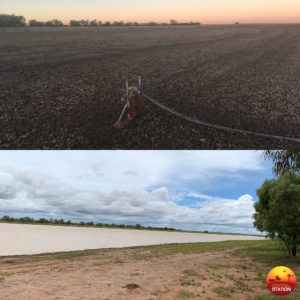
They were taken nine months apart from about the same spot. I say ‘about’ because the dry, desiccated mud flat where I took the first shot last year is now under a considerable amount of water and, knowing the size of the salt water crocodile that kicks around in there I’m not keen to go in just to recreate a photo.
This is Goose Hole billabong – a beautiful water hole about 1.5kms away from the Kalyeeda homestead. We have always pumped water from this billabong to supply the cattle yards and homestead. It’s a glorious spot with an abundance of bird and wildlife. It’s always been one of my favourite sunset drink spots, although as home to a plethora of crocodile chums including the aforementioned Massive Salty, it’s not a place I’d dip my toe for a swim. Generally speaking, though, it’s an idyllic scene.
This was not so last year, however. In 2019 Kalyeeda, like so much of the rest of Australia, had a dry year.
On paper we had within our average rainfall, so we should have been fine. Indeed, the grass grew beautifully and there was plenty of feed around for the creatures that could access it. But unfortunately, the mighty Fitzroy River, the lifeblood of our valley, did not flood and burst its banks as it usually did.
This lack of flooding had been preceded by a poor wet season the year before, and those two factors combined were enough to give the delicate ecosystem some problems.
You see, without the big river flooding out the landscape as usual, the surface rain alone had not been enough to fill the numerous water holes around the station that provided water for the many creatures that call Kalyeeda home.
By April things were already starting to run dry.
By May it was a desert scene.
This did mean I was able to have some fun times riding my horse across the middle of the billabong searching for fish and croc skeletons. We also had some fairly awesome bonfires and barbecues out on the cracked mud flat that had been left behind. But it also signalled that we had to change a few practices and put in a few strategic measures if we wanted to end the season with all of our charges still happy and well fed and watered.
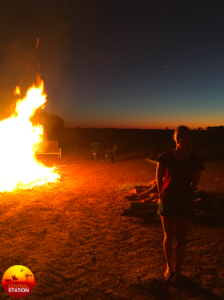
I have been at Kalyeeda once before when it was so dry that even the sizeable Goose Hole dried up. That was more than ten years ago. I have no pictures of that time because it was not a happy one.
My lingering memories of that year are of late in that season when James and I – alone on the station at that time – were driving out twice or three times a day to the known trouble spots where the water holes were going boggy. We would look for and inevitably find weak, bogged cattle that we then had to drag out of the sticky mud and try to stand up on their feet. They were often too weak to get up alone.
This act, if successful, was often followed by said cow trying to eat us as, in her dehydrated state, she did not understand we were trying to save her life. In spinning and trying to charge us down she was likely to end up back on the ground and at square one.
I remember trying to move cattle on as gently as possible from one dried up billabong to the next one that held enough water to give the mob a drink. I remember endless bore runs around our six troughs throughout the property to see the lucky animals that watered there. I remember the dread when one of the mills that kept the precious water coming broke down. I remember praying for rain and then swearing when all we got was a lightning storm followed by the inevitable fire on the tinder-dry grass.
That was not a fun year. We simply did not have the infrastructure in place to cope.
But 2019 was different. We had plans.
Peter and James have long been striving to make Kalyeeda as strong and sustainable as possible. We have vast swathes of open country but its ability to nourish is limited by a lack of drinking water. Peter has been found on many occasions pouring over maps of fault lines and talking with geologists and water diviners alike, trying to puzzle out a master plan to sink some bores and make some dams to make the most of what nature has given us.
And we’ve done pretty well. In the thirteen years I’ve been involved with Kalyeeda we’ve gone from six bores run by either windmills or diesel generators to 20 – mostly utilising solar power. It’s been amazing to see the country thrive as the grazing pressure changed and the land was opened out to bird and wildlife that didn’t previously get a look in.
Last year’s conditions really sped up the rate of improvements. We bought a whopping 26 troughs, assembled 6 tanks and sank 3 bores. It was hard work on the stock crew. After the usual exhausting first round muster there was no letup – they were straight into the ambitious plans to lay pipes, cement in troughs and build tank enclosures all over the wilds of the station.
This year we were determined to beat the drought.
The team often had to split up. One lot would be out mustering in sale cattle, the other digging trenches and laying out kilometres of poly pipe. The poly welder was a piece of equipment that got a good working out. As was the phrase:
“Careful! You’re gonna kink it!”
400m long rolls of pipe that are taller than you are with your arms stretched above your head can be pretty unruly.
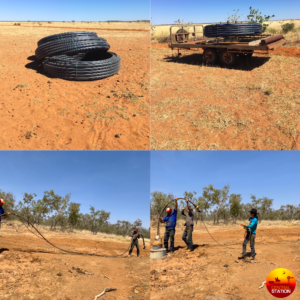
But it paid off. Come October, the long-awaited dream of opening up the country with water had been realised. Cattle were grazing happily in areas they would previously have had to walk too far to be able to pick at.
And it was just in time because the season has continued to be unrelenting.
Looking around the cattle that camped at the beautiful new troughs, those tiny calves we had branded in first round just a few short months ago were now big, sappy weaners, still drinking off the mothers they were nearly two thirds of the size of. We needed to muster again and pull them off the cows before the patient old girls started to struggle.
But the weather continued to challenge us. It was hot. So hot. Already.
No one – not man nor beast – felt like the long, hot walks to get to our yard sites.
Our situation: We really needed to muster to pull off weaners.
Our problem: it was already stinking hot and only getting worse and we didn’t want to stress our mama cows.
Our solution: It was time to bring out the panels.
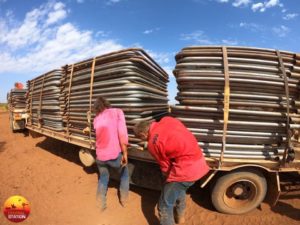
It’s long been known around the area that family Camp has a bit of an affinity for portable panels. Peter has a long list of experience mustering in the wilds and has amassed a fairly encyclopaedic knowledge of how and where to set up portable yard sites – not to mention owning the hundreds of panels you need to make these dreams (or nightmares) come true.
He’s passed on that passion to his son, James the Muster Planner in Chief, who got a glint in his eye when he explained his intentions to the crew:
“Rather than a couple of big musters we’re gonna do a whole heap of small ones – no choppers, just us on horses. Two days each. Bam. Bam. One day to set up and one day to process.”
The looks of dread on these bright young faces was a sight to behold. Anyone who has ever worked with portable panels before knows that they signal heavy, awkward, backbreaking work.
The plan was simple; now that we had all these lovely troughs dotted around it was easy to find where the cattle would be hanging on these hot days – around these glorious water points. We would go in and build a small portable panel yard site about a kilometre away from the chosen trough. A small and simple design made for little mobs and a quick two-way draft – it should be easy.
The next day we would go to the troughs with horses and wait for the cattle to come in to water, then walk them off to the yards. It was going to be quick and effective. Cows went straight back out and weaners were pulled off the side into a holding yard. That afternoon the stock crew split in two – one group worked to truck the weaners back to the homestead yards while the other began moving panels onto the next trough and the next yard site.
What a perfect, low stress plan! For the cattle, I mean. It caused a fair amount of exhaustion in the crew, as well as a few interesting impromptu games and competitions as you always get when given a bunch of fun, energetic young folk and a repetitive job to do.
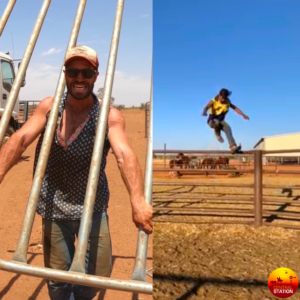
James still holds the record for the speediest panel building skills (I’m trying really hard not to use the word erection here…), though no one could beat TJay for agility in clearing the six-foot obstacles with no hands. Quite a useful skill around some cranky mama cows.
But the plan was not perfect – we were still thwarted by nature.
One particularly memorable site we were hit by a hail storm mid-muster which, while proving to be fairly precarious in dodging angry cows on a mud rink, also meant the next day’s planned mini-muster was a non-starter. The cattle we had expected to be huddled around the trough complaining about the heat had actually buggered off chasing the green pick that the early break was sure to provide.
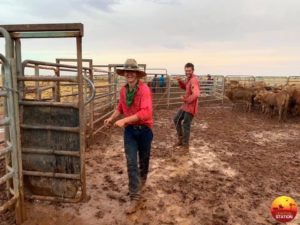
All in all, it was a success. Weaners were pulled off with a minimum of disruption to mob life and the mama cows were left in peace to calf down with their next babies.
And certainly, the experience gave the whole stock camp each a set of shoulder muscles to rival a squad of elite swimmers – who doesn’t want that!?
As I sit and look back on 2019 now, I am doing so knowing that our billabongs are already chock-a-block and, judging by the stormy grey clouds swirling around the sky above me, we are still set for more rain.
I know the conditions we experienced last season was nothing for us compared to the struggles faced by so much of Australia. In my thirteen years at Kalyeeda we’ve had only two that have seen out homestead billabong go dry, and that’s not something we take for granted.
We can only do what we can to protect ourselves and the life and land we look after from mother nature’s harsh side. But, I know that based on my experiences ten years ago compared to last year, and considering the gloomy outlook touted by climate experts, I find it a reassuring thought that our efforts in planning for and responding to these challenges are rising to meet the hardships we will no doubt face again in the future.
